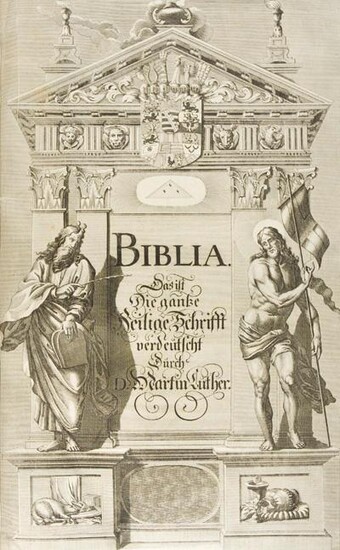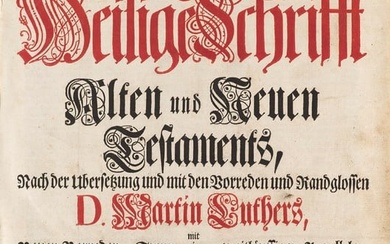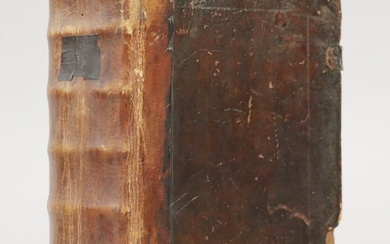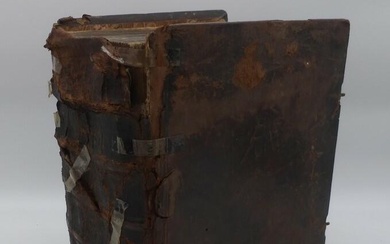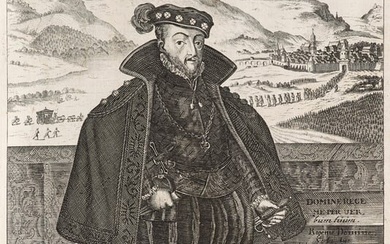Biblia, Das ist die gantze Heilige Schrift, Altes und Neues Testaments. Verdeutscht von Herrn Doctor Martin Luther: Und auf gnädigste Verordnung Des Durchlauchtigsten Fürsten und Herrn, Herrn Ernsts, Herzogen zu Sachsen, Fülich, Kleve und Berg von...
By Salomon Cyprian, Ernst (Preface by); J. C. Claussner (Engravings by)
Folio (17 3/4 x 12"). [2] leaves (Half-title and title), [12]pp (Preface of the 1736 second edition), [2]p (Note to the Christian reader on this new 1768 edition), [16]pp (Preface to the 1640 [i.e. 1641] edition), [2]pp (List of Saxony's Electors), 11 leaves (Engraved portraits of the Electors), [1] leaf (Engraved portrait of Martin Luther), [8]pp (Short introduction and instruction regarding the Holy Scriptures), [2]pp (Calendar), [13]pp (Index), [26]pp (Name Index), [11]pp (Chronology), [1]pp (Personalities in Maccabee and Herodium), [7]pp (Explanations on the Old Testament), [5]pp (Charts of calendars, weight, money, measures and distance used in the Bible), [4]pp (Chronological order of the Books of the Bible), [7]pp (Register / Table of the Old Testament), [3]pp (Preface of the Old Testament by Martin Luther), [3] leaves (Engraved plates), 740pp (Old Testament). [1] leaf (Engraved title of the Prophets), [1]-328pp (The Prophets), [2] leaves (Engraved title for Apocrypha, and plate), 329-512pp (Apocrypha), [4] leaves (Engraved title and three plates for The New Testament), 472pp (New Testament), 473-480pp (Constitution and harmony of the Gospels), [8]pp (Detailed plans of Jerusalem), [14]pp (Confessio). Richly gold-tooled calf with spectacular foredges stamped & tooled in gold. Foredge shows a sunburst with architectural motifs. Top and bottom edges with architectural motifs only. Front and back board with brilliant gold-tooling of a Greek temple, small motifs on top and bottom representing the seats for the bishops, all within amazingly detailed gold-tooled border. Rebacked, retaining original spine. Dentelles. Engraved half-title by J. C. Claussner, preceded by the printed title. Decorative head-, tailpieces and initials. In 1641 was published the first edition of the so-called "Weimar Bible" compiled under the auspices of Ernest, Duke of Saxony-Jülich-Cleves-Berg, by Johann Gerard, Salomon Glass and others. This striking 1768 copy is the third and last edition of the "Weimar Bible" also called "Kurfürstenbibel" (the Electors' Bible) as it features eleven full page engravings depicting Saxony's Electors from Friedrich III to Bernhard der Große (plates numbered 1-11), followed by an engraved portrait of Martin Luther. (see Darlow & Moule 4217 for the 1641 edition and Darlow & Moule 4234 for the 1768 edition). This Bible was published with added in-text explanations of Luther's original translation to better facilitate the understanding of the biblical text. Illustrated with 49 plates (including 12 engraved titles and inter-titles), most of them are full-page engravings (29), with 4 double-page, as well as 4 double-page maps and plans. With the rare fold-out engraving at rear showing the royal entourage in the large reception hall during the "Confessio"* which took place in Augsburg in 1530. Individuals and parts of the architecture in the hall are identified on the actual plate with small numbers ranging from 1 to 47. The opposite page lists each number with the name and title of the person depicted as well as explanations of parts of the architecture. This plate is usually missing in most copies. Small area on rear of the plate has been expertly repaired. All engravings in this bible are by Clausner. Engraved titles and decorated initials throughout. Minor age wear to binding. Some staining to endpapers. Last page chipped on bottom edge not affecting text. Slight staining and foxing to few pages. Text in German, Gothic script. Tight copy in a stunning binding with exquisite illustrated page edges. In overall very good condition. Darlow-M. 4234 for 1736 edition. * The Augsburg Confession, also known as the "Augustana" from its Latin name, Confessio Augustana, is the primary confession of faith of the Lutheran Church and one of the most important documents of the Lutheran Reformation. The Augsburg Confession was written in both German and Latin and was presented by a number of German rulers and free-cities at the Diet of Augsburg on 25 June 1530. The Holy Roman Emperor Charles V had called on the Princes and Free Territories in Germany to explain their religious convictions in an attempt to restore religious and political unity in the Holy Roman Empire and rally support against the Turkish invasion. It is the fourth document contained in the Lutheran Book of Concord. Third and last edition of the Weimar Bible.
Published by: In Verlegung der Johann Andrea Endterischen Handlung, Nürnberg, 1768
Vendor: ERIC CHAIM KLINE, BOOKSELLER (ABAA ILAB)
Buy Now on
By Salomon Cyprian, Ernst (Preface by); J. C. Claussner (Engravings by)
Folio (17 3/4 x 12"). [2] leaves (Half-title and title), [12]pp (Preface of the 1736 second edition), [2]p (Note to the Christian reader on this new 1768 edition), [16]pp (Preface to the 1640 [i.e. 1641] edition), [2]pp (List of Saxony's Electors), 11 leaves (Engraved portraits of the Electors), [1] leaf (Engraved portrait of Martin Luther), [8]pp (Short introduction and instruction regarding the Holy Scriptures), [2]pp (Calendar), [13]pp (Index), [26]pp (Name Index), [11]pp (Chronology), [1]pp (Personalities in Maccabee and Herodium), [7]pp (Explanations on the Old Testament), [5]pp (Charts of calendars, weight, money, measures and distance used in the Bible), [4]pp (Chronological order of the Books of the Bible), [7]pp (Register / Table of the Old Testament), [3]pp (Preface of the Old Testament by Martin Luther), [3] leaves (Engraved plates), 740pp (Old Testament). [1] leaf (Engraved title of the Prophets), [1]-328pp (The Prophets), [2] leaves (Engraved title for Apocrypha, and plate), 329-512pp (Apocrypha), [4] leaves (Engraved title and three plates for The New Testament), 472pp (New Testament), 473-480pp (Constitution and harmony of the Gospels), [8]pp (Detailed plans of Jerusalem), [14]pp (Confessio). Richly gold-tooled calf with spectacular foredges stamped & tooled in gold. Foredge shows a sunburst with architectural motifs. Top and bottom edges with architectural motifs only. Front and back board with brilliant gold-tooling of a Greek temple, small motifs on top and bottom representing the seats for the bishops, all within amazingly detailed gold-tooled border. Rebacked, retaining original spine. Dentelles. Engraved half-title by J. C. Claussner, preceded by the printed title. Decorative head-, tailpieces and initials. In 1641 was published the first edition of the so-called "Weimar Bible" compiled under the auspices of Ernest, Duke of Saxony-Jülich-Cleves-Berg, by Johann Gerard, Salomon Glass and others. This striking 1768 copy is the third and last edition of the "Weimar Bible" also called "Kurfürstenbibel" (the Electors' Bible) as it features eleven full page engravings depicting Saxony's Electors from Friedrich III to Bernhard der Große (plates numbered 1-11), followed by an engraved portrait of Martin Luther. (see Darlow & Moule 4217 for the 1641 edition and Darlow & Moule 4234 for the 1768 edition). This Bible was published with added in-text explanations of Luther's original translation to better facilitate the understanding of the biblical text. Illustrated with 49 plates (including 12 engraved titles and inter-titles), most of them are full-page engravings (29), with 4 double-page, as well as 4 double-page maps and plans. With the rare fold-out engraving at rear showing the royal entourage in the large reception hall during the "Confessio"* which took place in Augsburg in 1530. Individuals and parts of the architecture in the hall are identified on the actual plate with small numbers ranging from 1 to 47. The opposite page lists each number with the name and title of the person depicted as well as explanations of parts of the architecture. This plate is usually missing in most copies. Small area on rear of the plate has been expertly repaired. All engravings in this bible are by Clausner. Engraved titles and decorated initials throughout. Minor age wear to binding. Some staining to endpapers. Last page chipped on bottom edge not affecting text. Slight staining and foxing to few pages. Text in German, Gothic script. Tight copy in a stunning binding with exquisite illustrated page edges. In overall very good condition. Darlow-M. 4234 for 1736 edition. * The Augsburg Confession, also known as the "Augustana" from its Latin name, Confessio Augustana, is the primary confession of faith of the Lutheran Church and one of the most important documents of the Lutheran Reformation. The Augsburg Confession was written in both German and Latin and was presented by a number of German rulers and free-cities at the Diet of Augsburg on 25 June 1530. The Holy Roman Emperor Charles V had called on the Princes and Free Territories in Germany to explain their religious convictions in an attempt to restore religious and political unity in the Holy Roman Empire and rally support against the Turkish invasion. It is the fourth document contained in the Lutheran Book of Concord. Third and last edition of the Weimar Bible.
Published by: In Verlegung der Johann Andrea Endterischen Handlung, Nürnberg, 1768
Vendor: ERIC CHAIM KLINE, BOOKSELLER (ABAA ILAB)
